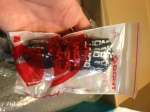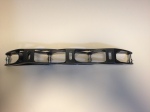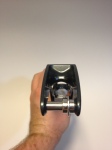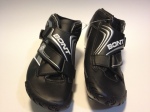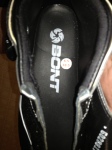Last year, I picked up a set of Atom One IQ X-Flex wheels from the Luigino Outlet. I try to shop the outlets as often as possible to save money. For most of us who are hobbyist sportsmen or sportswomen, we are always struggling to keep up with the curve of technology while still getting the most our out of our limited dollar. When I raced motocross, the penny pinch was much worse. We would calculate upgrades, and build our bikes to last as long as possible between repairs and upgrades. The same rules applied when we switched to go-carts. Now, chest deep in Inline Speed Skating, the same rules apply. With top boots in the $1,500 range, and top end wheels running $26 per wheel, a full set of world class custom skates can run close to $2,000. While inexpensive to get into the sport, compared to cycling where a set of wheels can cost as much as high end skates, the tough part about skates are the components that need to be regularly replaced, or have specific uses based on conditions. Wheels are a terrific example. Conditions have a direct effect on wheel choice. Harder wheels are better on smoother surfaces. Rain requires wheels that grip in wet conditions, which can be a rare characteristic of urethane wheels. Wheels, though, are rarely on sale, and when they are, they are usually much older models that have been succeeded by much better technology.
I previously discussed the trouble I had with the Atom One IQ X-Flex wheels. The 8 that I purchased all had significant hub failure, where each of the hubs developed splits or cracks such that they were no longer safe to use. When I contacted Nistevo, the parent company that operates Atom Wheels, they were reticent to help resolve the problem because the purchase originally came from the outlet, which has an as-is warranty policy. After several email exchanges the manufacturer agreed to replace the defective wheels with the current generation wheels that were one step below the wheels I purchased on close-out: Atom One X-Flex wheels in 87a.
I planned on saving these wheels to use as my racing wheels for the 2012 racing series. However, I got in on the Bont Black Ops wheel deal when I signed up for NROC. As a result, I pitched the Bong G3 wheels, and moved the Atom One wheels into the position of my everyday wheels. I have used them with my Bionic Swiss bearings, also from Luigino, and my older ILQ9 Classic bearings. The wheels are consistent regardless of which bearing is used.
Out of the package, these are great looking wheels. The X-Flex hub means the hubs are different than the regular Atom Reflex hub. The pictures that follow are good examples. The black hub wheels are the Atom One X-Flex wheels, the white hub wheels are Atom One IQ Reflex wheels (I have a couple spares in case I need them).

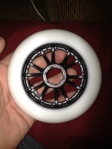


You can see the difference in the hubs on these wheels. The Reflex core has become the staple of the Atom IQ wheels. Apparently, the IQ flex band mixed with the x-flex core makes the feel too soft, even at a higher durometer. I wouldn’t have thought this was an issue, and I didn’t notice this as a problem with my X-Flex IQ wheels. However, at that time, I wasn’t pushing hard enough to be able to feel the difference. Now, though, I think I am in a position where I push harder, with better form, and can feel more of how the wheels react in different situations.
Generally, these wheels are hard. At 87a, that is to be expected. You can feel the hardness from the durometer on rougher roads. They don’t feel as hard as the Bont G3 wheels, which is odd because those wheels are 84a durometer. The hub is what plays a part here. The rebound isn’t very strong on these wheels, again, I think, due to the hardness, but the hubs make the difference. The slimmer X-Flex hubs really flex well, and make the harder wheel more responsive than would be expected with a stiffer hub. As a result, the hardness of the wheel and the flex in the hub make them a solid wheel for smoother conditions. This is a great place to start on a wheel.
Another big benefit from these wheels is the roll. They roll as well as the IQ X-Flex version. This is great for keeping momentum while skating. You don’t feel like you have to fight the gear for speed. When you are skating with great form, increased roll helps the skates work for your push, so that you can save energy in a long race. These wheels do very well with roll. However, they don’t roll as well in rougher conditions. In fact, the wheels start to feel dead in rougher road conditions. I think this is due to a lack of rebound.
Generally, I haven’t really thought about the benefit of rebound. Softer urethane has good rebound in theory, while harder urethane shouldn’t rebound as well. However, the Bont G3 wheels have terrible rebound, partly due to a hard hub. This is odd since they are softer wheels than the Atom One wheels that are the subject of this review. The urethane in these wheels feels true to form, in that it lacks rebound. This probably helps with roll, but makes the wheels feel dead on a rough surface. The flex in the hub, while providing great snap, doesn’t totally compensate for the lack of rebound in the wheels.
Grip is the other concern with these wheels. They seem to grip well on their normal profile, especially after the exterior coating comes off. However, I find they slip at the end of the push, particularly in a deep squat at speed. They also have a hard time holding very tight corners at speed. To a degree, this is to be expected with a wheel this hard. They do grip better than the Bont G3 wheel for the most part, but the slip at the end of the push sacrifices power and speed. A lot of the slipping may be driven by the surface, though. It seems to occur in different situations more often, like on rougher surfaces, or older tarmac. Similarly, if my weight is too far forward, I find the rear wheels snake a bit in the push. Otherwise, the grip is consistent on most surfaces, and hasn’t given me reason to be concerned.
The wear on these wheels are terrific. I have at least 200 miles on these wheels, and they haven’t lost much more than millimeter of surface. They don’t need to be rotated very often, which means more skating and less up-keep, which is great for the fun of the sport because it means more time skating.
Bottom Line: These are great wheels if you like harder wheels. They are acceptable on rougher surfaces, but this is the only serious draw back to these wheels. As a training wheel, these are perfect for most road conditions. They roll very well wear very well. If you can find these wheels on a close-out, pick up a set. I am going to keep my eye out for more in the future. However, these are an older technology wheel. Atom has released the Matrix line, which is the updated road wheel from Atom. The regular Matrix is, from what I understand, very similar to this wheel. The Matrix IQ is an updated Atom One IQ that is supposed to have new technology in the flex band. Atom is no longer incorporating the X-Flex hub into the IQ wheels. If you want to stay competitive, you need a banded wheel. However, these are great wheels for general skating and racing on a budget.








